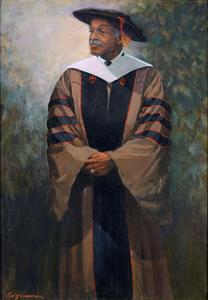
Redding, Jay Saunders (1906 - 1988)
Role: Professor of English, FellowDates: 1949 -1950, 1969 - 1981
Portrait Location: Sayles Hall 108
Artist: Freeman, Robert (b. 1946)
Portrait Date: 1992
Medium: Oil on canvas
Dimensions: 59 1/2
Framed Dimensions: 63 1/2
Brown Portrait Number: 254
Brown Historical Property Number: 2205
Jay Saunders Redding was the first African American appointed to the Brown faculty. Born in Wilmington, Delaware, in 1906, Redding transferred from Lincoln University in Pennsylvania to Brown, where his brother Louis had graduated in 1923. Redding graduated from Brown in 1928, taught at Morehouse College until 1931, and returned to Brown for a master's degree in 1932. Redding taught English at several southern colleges before being named head of the English Department at State Teachers College in Elizabeth City, North Carolina. In 1943 he moved to the Hampton Institute, where he taught English until 1966. It was during this time that Redding spent a year at Brown (1949-1950) as a visiting professor. His course on blacks in American literature was the first course of its kind taught at a northern college. In 1969 Redding was a professor of American history and civilization at George Washington University and from 1971 to his retirement in 1975, he was professor of American Studies and Humane Letters at Cornell University. Throughout his career, Redding remained concerned with the African-American experience in the United States. His first book, To Make a Poet Black (1939), was followed by many others on the black experience, including the autobiographical No Day of Triumph (1942), a novel Stranger and Alone (1950), They Came in Chains (1951), On Being Negro in America (1951), The Lonesome Road (1958). His 1954 An American in India was commissioned by the U. S. State Department, and his 1967 The Negro by the U.S. Information Agency. During his life, the New York Times hailed Redding as the most important black non-fiction writer in the country.
Boston-area painter Robert Freeman was commissioned to paint Redding's portrait posthumously by President Vartan Gregorian. He based the portrait on a photograph made by John Forast? showing Redding in his academic regalia during the 1978 commencement exercises. Freeman teaches art at Noble and Greenough School in Massachusetts.
